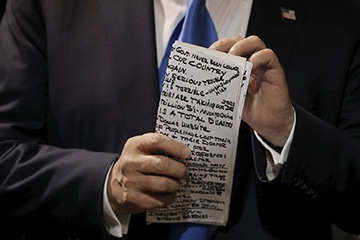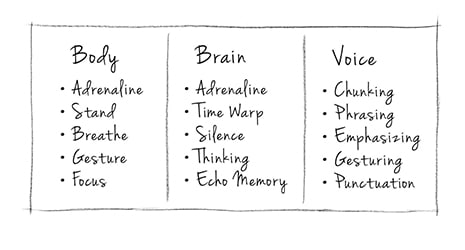I coach hundreds of lawyers one-on-one each year. When they plop their legal pads on the table as we work, I can see the notes they have created for public speaking or trial advocacy. With just a glance, it’s immediately obvious how unhelpful those notes are for the task at hand. Written too small and illegibly, they lack any discernible visual structure. Like a newspaper without headlines over articles, the topics often have no headlines, and no beginning or ending. A lawyer giving a presentation or conducting an examination of a witness cannot possibly find such notes very helpful.
What Would Donald Trump Do?
I was reminded of the usefulness of notes while reading a recent article in the New York Times about the U.S. presidential primary candidates.
One of the photographs focused on notes held in the hands of the Republican front-runner. The picture is revealing. Commentators criticize the meandering flow of Trump’s campaign speeches. If you look at his notes, it is obvious that they are one reason why this happens.
Even this view of a partial page reveals no discernible structure to the presentation. No beginning, no middle, and no ending. One can read the entertaining hyperbole for which his speeches are famous, or infamous: “NEVER BEEN LOWER,” “SERIOUS TROUBLE,” and “TOTAL DISASTER.” But he is not the kind of speaker who offers listeners a clear structure, such as:
- Big problem
- Possible options
- Best solution
If you imagine yourself as the speaker using notes like Trump’s, how do you know where to look on the page when you need to glance at them? Top? Middle? Bottom? Right? Left? Center?
To examine this issue another way, imagine if Trump’s page of notes were projected on a screen as a PowerPoint slide. How preposterously unhelpful such a visual aid would be to an audience trying to read it. It would be a “total disaster,” leaving the viewer in “serious trouble,” to quote Trump himself.
Your Notes Need to Be a Visual Aid for You, the Speaker
Notes are not a script to be read, but a structure to be consulted, like a map that guides you through a series of ideas to a logical destination. The obvious rules of visual aids apply:
- Write big.
- Write legibly.
- Keep it simple.
But those suggestions are just the beginning of a workable solution for better notes. An even more radical idea is what we call “horizontal notes,” and it works well for many speakers.
Think of the visual structure and presentation of information on many of your favorite applications and websites. Buttons for each topic are arranged horizontally on the navigation bar across the top. Pull-down menus below each button offer more detail. Those buttons serve a purpose similar to the headline at the top of a newspaper article, telling the reader what lies below. Your notes for public speaking could imitate that structure.
Escape the trap of vertical notes that flow from top to bottom down the page. Instead, create notes that flow horizontally across the page. The structure is clear. You will benefit and so will your audience.
Video: “Notes are a visual aid for the speaker”
Watch our video, “Notes as a Visual Aid for the Speaker,” for more tips on using the horizontal notes method.
Thumbnail Illustration © iStock.com; graphics and video courtesy Crown King Books and Brian K. Johnson.























